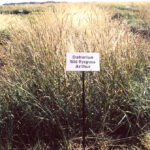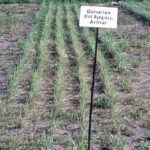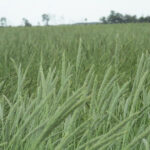Dahurian Wildrye
Elymus dahuricus
General Description
Dahurian wildrye is a short-lived, shallow-rooted perennial bunchgrass. It tends to be a less used species even through it establishes quickly. Dahurian wildrye and slender wheatgrass are now classified within the same genus.
The stems of Dahurian wildrye are erect and can grow to 100 to 150 cm (39 to 60 in) high. The leaves are 11 to 15 mm wide with prominent veining, and lax with long (130 to 235 mm or 5 to 9 in) leaf sheaths and internodes. The leaves are high on the stem. The seed is generally longer and wider than that of Russian wildrye, Psathyrostachys juncea, and frequently has awns 10 to 20 mm (.4 to .8 in) in length.
Type
Tame grass.
Origin
Siberia, Mongolia, China. Varieties “James” and “Arthur” developed in Canada.
Longevity
Less than 5 years. Low persistence.
Use
Pasture, hay. Dahurian wildrye is used primarily for short-term pasture or hay forage, but because of its adaptability, ease of establishment, and shorter life span, it may have some application in restoration. It can establish very quickly.
Optimal Time of Use
Spring, summer. Dahurian wildrye can be continually grazed, but responds best to rotational grazing for maximized regrowth. Dahurian wildrye begins growth early and should be grazed before it gets coarse. It can be used in the year of establishment, especially under moister site conditions. Hay at heading for best palatabilty.
Recovery After Use
Requires a minimum 30 to 60 days of recovery after use. Dahurian wildrye is quick to regrow and can be grazed 2 to 3 times within the season, soil zone dependant.
Palatability/Nutritional Value
Dahurian wildrye is quite palatable and has good forage quality when it is growing. Palatability decreases after heading. Unlike Russian wildrye, it does not cure well standing, although when cut at the immature stage hay quality may be as good as crested wheatgrass.
Annual Precipitation min/max (mm)
300mm / 600mm
Drought Tolerance
Good tolerance.
Flooding Tolerance
Withstand up to 4 weeks of flooding in the spring. Tolerates moist soils well.
Winter Hardiness
Good hardiness. Short longevity overall.
Soil Texture Preference
Dahurian wildrye can be grown on a wide range of soil textures.
Erosion Control
Dahurian wildrye is not suitable for erosion control.
Salinity Tolerance
High tolerance.
Acidity Tolerance
Low tolerance.
Alkalinity Tolerance
Moderate tolerance.
Seeds per kg
194,000 seeds/kg (88,000 seeds/lb)
Suggested Mixtures
Suitable for mixtures. Dahurian wildrye can be paired with other short lived forages for a short lived stand. Otherwise, use Dahurian wildrye as a short lived, starter species with long lived forages that will take over a stand as Dahurian wildrye dies out. Darhurian wildrye will compete strongly in a new stand.
Ease of Establishment
Dahurian wildrye is easily established, has excellent seedling vigour, and is very competitive with other crops such as legumes.
Competitiveness
Dahurian wildrye is very competitive in the year of establishment but becomes less competitive as the stand ages. It will die out of the stand in less than 5 years. Dahurian wildrye is not considered invasive.
Management Considerations
Dahurian wildrye is sometimes seeded in wide or perpendicular rows with other longer-lived perennials to provide additional forage in the first year of establishment. Manage for short term use.
British Columbia Rangeland Seeding Manual, Saskatchewan Dryland Forage Species Adaptation Tool, USDA Plants Database, Manitoba Forage Adaptation and Comparison Guide, Alberta Forage Manual
Dahurian wildrye is adapted to all zones in the Central Interior, but is less adapted to the driest (semi-arid) parts of the bunchgrass zone.
Dahurian wildrye is adapted to all zones in the Southern Interior, but is less adapted to the driest (semi-arid) parts of the bunchgrass zone.
Dahurian wildrye has moderate to high winter hardiness, but can winter kill in very severe winters. Trials with this species would help establish its suitability for use in the Peace-Liard region.


